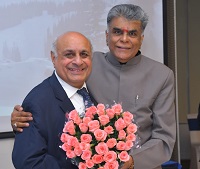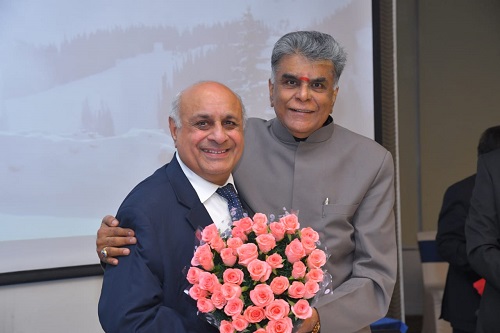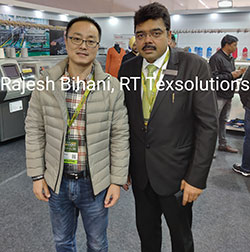FW
SRTEPC has prepared a 20-point strategy for the development of MMF fiber textile segment. The points include: bringing in fiber neutrality, lowering interest rates, making raw materials to be made available at international price, considering textile job work as manufacturing in the goods and services tax regime, considering textile merchant exporters as manufacturer exporter, branding and WTO-compatible schemes.
SRTEPC says, exports of Indian man-made fiber (MMF) textiles are expected to grow 10 per cent to reach $7 billion by the end of fiscal 2020-21. Exports in value-added segments like fabrics witnessed nearly 8 per cent growth during April-October period in 2019-20 as compared to the same period in the previous fiscal.
Indorama Ventures has bought the chemical intermediates businesses of Huntsman Corporation including PO/MTBE, and its surfactants businesses. The transaction is valued at around $2 billion, which comprises a cash purchase price of $1.93 billion along with the transfer of up to $76 million in net underfunded pension as well as other post-employment benefit liabilities. Notably, the cash purchase price includes estimated adjustments to the working capital purchase price.
The transaction significantly lowers Huntsman’s capital-intensive upstream asset base, strengthens its already strong balance sheet, and enables it to further invest and expand its downstream businesses. It also expands the company’s opportunity and flexibility for select strategic and accretive acquisitions, and ongoing opportunistic repurchases of its shares.
The divestiture will also enable Huntsman to generate more stable and consistent margins as well as strong free cash flow.
Himatsingka plans to launch new lifestyle bedding and bath brand Himeya at Heimtextil. The brand will bring back the beauty of the outdoors into its customers’ lives and homes. This is a part of the company’s broader efforts to spearhead a spectrum of initiatives designed to enhance market share across Europe and Asia Pacific for Himatsingka’s home textile portfolio.
Himatsingka’s theme at Heimtextil this week is “The Architecture of Comfort” as the event sets the tone for the company’s redesigned booth at the show. The company tapped Swedish interior designer and stylist Lotta Agaton to creatively present this visual expression. The company also plans to launch new Rescue Towel program made of repurposed yarn waste and its tagged cotton story at the exhibition.
Himatsingka is the only company equipped with the DNA to track and trace cotton from farm to home. The company has positioned itself as a leader in the track-and-trace space using the unique, patented DNA system by Applied DNA Science.
Bangladesh will give garment, terry towel and specialised textile exporters a one per cent special incentive. The aim is to help exporters remain competitive in the global market. Currently, Bangladesh garment exporters receive a four per cent cash incentive for shipment to non-traditional markets. The country considers all destinations as non-traditional markets except the EU, the US and Canada.
Bangladesh’s garment exports have been declining for the last five months because of currency appreciation, rising cost of production, lower consumer spending on garments and the free trade agreement between Vietnam and the EU. In the first half of the fiscal, Bangladesh’s apparel shipments fell 6.21 per cent. The US-China trade war resulted in a slump in consumption of readymade garment products. Consumption fall also forced the country’s exporters to lower prices. The readymade garment sector contributes 83.52 per cent to the country’s overall export earnings. Due to Bangladesh’s high dependency on garment exports, any instability in this sector in future could result in huge unemployment and a trade deficit. So the country needs to diversify its export basket. Bangladesh has to develop factory to port communication in order to reduce lead times and has to have a one stop service in trade procedure and documentation in product transaction.
Aviraté has partnered EFL in order to provide customers a seamless brand experience. EFL is a global supply chain service provider. Its apparel finished goods specific infrastructure is capable of keeping garments fresh from the point of manufacture till purchase. By regulating humidity and temperature it prevents mold formation which is vital and often overlooked especially in countries like Sri Lanka with a relatively high humidity of about 85 per cent. Avirate, based in Sri Lanka, is a luxury women’s fashion retailer with five retail stores across Sri Lanka and hopes to continue on this trajectory with expansion into Europe, North America and the Middle East.
Having made considerable changes to its supply chain and business conditions, Avirate decided to focus on specialized warehouse operations, distribution and inventory management of its products. Aviraté found the perfect fit with EFL to change the way its business process solutions are managed and delivered effectively. The modern infrastructure that EFL offers suits this operating model in addition to superior industry compliance in terms of social, operational and business certifications. Avirate sees EFL as having the best infrastructure in the region and the experience and resourcefulness to be able to respond to Avirate’s changing business needs.
"Padma Shri Dr. A Sakthivel has taken over as the new chairman of the Apparel Export Promotion Council from January 6, 2020. He was elected to the Board of Directors of Apparel Export Promotion Council in the year 1982 and has served the council for almost four decades. He is also the first person in the history of AEPC, to be sworn-in for the fourth time as Chairman of the AEPC. His diligence has played a vital role in the growth of the Council and gradually led to the improvement of exports at the national level."
 Padma Shri Dr. A Sakthivel has taken over as the new chairman of the Apparel Export Promotion Council from January 6, 2020. He was elected to the Board of Directors of Apparel Export Promotion Council in the year 1982 and has served the council for almost four decades. He is also the first person in the history of AEPC, to be sworn-in for the fourth time as Chairman of the AEPC. His diligence has played a vital role in the growth of the Council and gradually led to the improvement of exports at the national level.
Padma Shri Dr. A Sakthivel has taken over as the new chairman of the Apparel Export Promotion Council from January 6, 2020. He was elected to the Board of Directors of Apparel Export Promotion Council in the year 1982 and has served the council for almost four decades. He is also the first person in the history of AEPC, to be sworn-in for the fourth time as Chairman of the AEPC. His diligence has played a vital role in the growth of the Council and gradually led to the improvement of exports at the national level.
Speaking on the occasion, Dr. A Sakthivel expressed concern over the stagnating exports and current industry scenario. He assured the members that he will work with full commitment and dedication to bring forth positive growth in apparel exports. He promised that he will put efforts to find new and potential markets for India's garment exports. He further assured that he will convince the senior officials of the Central Government to get the required incentives and benefits thereby reviving growth of the sector and overall exports.
Dr. A Sakthivel along with some exporters had established Tirupur Exporters Association in 1990 widely known as TEA. Dr. A Sakthivel was the first President of TEA and with his dynamism, he held the post continuously for a period of 27 years.
During his tenure as President of TEA, he toiled hard to develop the industry as well as Tirupur. The export turnover of Tirupur industry increased to a whopping Rs 27000 crores in 2016-17 from Rs 270 Crores in 1990.
Government of India recognised his unparalleled service to export sector specifically to apparel sector and knitting industry, creation of infrastructures such as industrial parks, ICDs and his contribution to society with regard to education, drinking water, sanitation, and drainage, etc., by honoring him with one of the country's most prestigious and esteemed Civilian Award Dr. A Sakthivel was also instrumental in so many visionary projects in Tirupur including the formation of Tirupur Export Knitwear Industrial Complex (TEKIC), Inland Container Depot (ICD), Netaji Apparel Park (NAP), International Exhibition Centre (IKF), etc. Similarly his social visionary projects include School for Children (TEA Public School), drinking water for Tirupur people and Industry through NTADCL, Fashion Knitwear Institute partnered with NIFT (NIFT-TEA Institute) etc.,
ICDs and his contribution to society with regard to education, drinking water, sanitation, and drainage, etc., by honoring him with one of the country's most prestigious and esteemed Civilian Award Dr. A Sakthivel was also instrumental in so many visionary projects in Tirupur including the formation of Tirupur Export Knitwear Industrial Complex (TEKIC), Inland Container Depot (ICD), Netaji Apparel Park (NAP), International Exhibition Centre (IKF), etc. Similarly his social visionary projects include School for Children (TEA Public School), drinking water for Tirupur people and Industry through NTADCL, Fashion Knitwear Institute partnered with NIFT (NIFT-TEA Institute) etc.,
Incorporated in 1978, AEPC is the official body of apparel exporters in India that provides invaluable assistance to Indian exporters as well as importers/ international buyers who choose India as their preferred sourcing destination for garments. In recent years AEPC has worked tirelessly in integrating the entire industry - starting at the grass the root level of training the workforce and supplying a steady stream of manpower to the industry; identifying the best countries to source machinery and other infrastructure.
Carvico has rewritten the rules of contemporary design by presenting its Lifestyle collection of fabrics for interior design at Heimtextil 2020.
The elasticity, resistance, breathability, versatility and countless options for customisation are the main features which make Carvico fabrics ideal for the interior design market.
Convertible, smart, multifunctional, and innovative, Carvico performance fabrics for furniture and design have been inspired by new trends and translate high tech performance into new shapes and styles to blend elegance and functionality with Made in Italy quality and excellence.
Original, function and innovative, Carvico Lifestyle collection features 3D textures and countless colors, strong and compact surfaces, fluid and comfortable velvets with a silky and sexy hand feel, cutting-edge, high-performance fabrics conceived to enhance shapes and volumes.
A selection of unique performance fabrics which, thanks to their bi-elasticity and resistance are ideal to cover furniture elements, to design whole rooms and complements. Extremely versatile and adaptable, handy and comfortable, easy to remove and to wash and fast drying, pilling resistant, and shape-retaining, they represent the perfect mix of quality, beauty, and functionality.
Carvico performance fabrics for the interior design market can be chosen in their standard version or the bonded, thicker and more compact one. Moreover, the addition of waterproofing membranes and treatments make them suitable also for the outdoor universe.
Beautiful, functional, high performance and with a green spirit. The Lifestyle collection includes several eco-sustainable fabrics, made of regenerated polyamide yarn from pre and post-consumer waste materials (ghost fishing nets, carpet fluff, and tulle ) which, at the end of their useful life, instead of being sent to the landfill, are recovered and regenerated through a complex physical-chemical process. This is how ECONYL® polyamide is produced to be then used for the creation of high-quality fabrics.
The National Council of Textile Organizations (NCTO), represents the full spectrum of U.S. textiles from fiber through finished sewn products, lauded Senate passage today of the U.S.-Mexico-Canada Agreement (USMCA).
Mexico and Canada being the two largest export markets for the U.S. textile and apparel industry, totaling nearly $11.5 billion for the year ending Nov. 30, 2019, according to government data.
“USMCA is an important for the textile industry,” Glas said. “The improvements it makes to the North American Free Trade Agreement (NAFTA) will only serve to generate more business for domestic producers and create more jobs and investment in the U.S.”
NCTO worked with the administration during negotiations on USMCA and secured several provisions in the trade deal including stronger rules of origin for certain textile inputs and increased U.S. customs enforcement.
U.S. textile executives are moving up to take advantage of the modifications in USMCA and some plan to build new business or expand existing business in areas such as pocketing, sewing thread and narrow elastics.
The USMCA updates and modifies the NAFTA and makes significant improvements, including, Creation of a separate chapter for textiles and apparel rules of origin with strong customs enforcement language. Stronger rules of origin for sewing thread, pocketing, narrow elastics and certain coated fabrics. Under the current NAFTA, these items can be sourced from outside the region USMCA modernizes this loophole and ensures these secondary components are originating to the region.
Fixes the Kissell Amendment Buy American loophole, ensuring that a significant amount the Department of Homeland Security spends annually on clothing and textiles for the Transportation Security Administration is spent on domestically produced products.
 “The knitting industry has grown over the past few years with over 4,500 machines making knitted shoe uppers in New Delhi today,” notes Rajesh Bihani, Managing Director, RI Texsolutions, a company engaged in manufacturing knitted shoe uppers for adults and children.
“The knitting industry has grown over the past few years with over 4,500 machines making knitted shoe uppers in New Delhi today,” notes Rajesh Bihani, Managing Director, RI Texsolutions, a company engaged in manufacturing knitted shoe uppers for adults and children.
Dismal outlook for future
However, the market is slow and the payment situation is bad. Petrol prices have shot up due to the US-Iran conflict with uncertainty prevailing in the market. “We don’t expect the situation to improve even in next six months. People making inferior products are more likely to face problems. We, at our company, always emphasise on the quality of our products. This helps us survive market upheavals,” explains Bihani.
Though the US-China trade war was expected to divert most Chinese business to India, however, it got diverted to Bangladesh, Myanmar, Vietnam. “We couldn’t take advantage of the situation as we don’t have the capacity to accommodate these orders. We also adjust our manufacturing quality according to the final cost of the product. Hence, we end up manufacturing most of our products with inferior machines,” affirms Bihani.
Government support needed to ensure market growth
As the Indian textile industry has to compete with global textile hotbeds like China, it needs the government’s support to grow. “We need to replicate the policies followed by China and Bangladesh. Though we have a market for branded products, the grassroots or local market has a bigger volume. Customers in this market are not very quality conscious. They focus more on the price of product. On the other hand, urban customers are more brand-driven and can be lured easily through publicity and shows. This scenario can change if customers start focusing on comfort, wearability and quality of product,” Bihani opines.
Another challenge the industry faces is the backdoor entry of finished garments from Bangladesh. These garments are not only of better quality but also better priced. “To compete with these garments, we need to revamp our attitude and ideologies. Right now, manufacturers are driven more by profits. They immediately switch to another business if they don’t make money in this one. They don’t wish to commit themselves to the industry. Training programs are seen more as costs rather than investment,” adds Bihani.
Dealing with competition
Offering solutions to deal with the current situation Bihani says younger entrepreneurs should involve themselves in production. “They should improve their productivity and efficiency. For this, each of their production units need to have an R&D department,” he points out.
Textile is the first industry to move out as a country develops. Indian companies too are shifting their bases to Ethiopia and Africa. “Though this is a positive sign, we are losing ground to competitors like China, which is improving its textile quality everyday. We need to buck up to stay ahead in the competition,” Bihani sums up.












